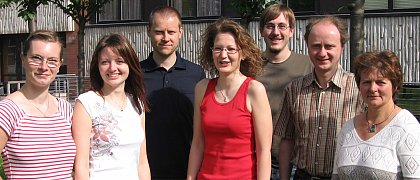The group of Thomas Brüser
RESEARCH

|
Tat-dependent translocation of folded proteins
The "twin-arginine translocation" (Tat) machinery is able to translocate folded proteins across biological membranes. Many Tat substrates even assemble cofactors like iron-sulfur clusters, molybdopterins, flavins, or nickel centers before translocation. Tat substrates may be much larger in diameter than the membrane thickness. Therefore the idea of translocation of folded proteins raises fundamental questions. What defines a Tat substrate? How does the Tat-machinery look like? What is the translocation mechanism? How is the process energized?
We study these questions in vivo and in vitro. We use Escherichia coli as a model organism. Our methods integrate molecular biology, biochemistry and general microbiology.
|
|---|
MEMBERS OF THE GROUP
(The group moved to the Leibniz University Hannover)
|
Thomas Brüser, Prof. Dr. habil., Institute of Microbiology, Leibniz University Hannover, Schneiderberg 50, D-30167 Hannover, Phone: +49 0511 7625945 (office), Fax: +49 0511 7625287, E-mail: brueser@ifmb.uni-hannover.de
|
|
Ute Lindenstrauß, technical assistant, Room 311 / 308, Phone: +49 345 55 26365 E-mail: u.lindenstrauss@mikrobiologie.uni-halle.de
|
|
Jana Behrendt, PhD Student (Microbiology), Room 311 / 308, Phone: +49 345 55 26365 E-mail: jana.behrendt@mikrobiologie.uni-halle.de
|
|
Felix Berthelmann, PhD Student (Microbiology), Room 311 / 308, Phone: +49 345 55 26372 E-mail: felix.berthelmann@mikrobiologie.uni-halle.de
|
|
Wenke Graubner, PhD Student (Microbiology), Room 311 / 308, Phone: +49 345 55 26365 E-mail: wenke.graubner@mikrobiologie.uni-halle.de
|
|
Denise Mehner, PhD Student (Microbiology), Room 308 / 311, Phone: +49 345 55 26372 E-mail: denise.mehner@mikrobiologie.uni-halle.de
|
|
Hendrik Osadnik, Diploma Student (Microbiology), Room 308 / 311, Phone: +49 345 55 26372 E-mail: hendrik.osadnik@mikrobiologie.uni-halle.de
|
|
Kristin Schulz, PhD Student (Biochemistry), Room 311 / 308, Phone: +49 345 55 26372 E-mail: kristin.schulz@mikrobiologie.uni-halle.de
|
|
Johannes Taubert, PhD Student (Microbiology), Room 308, Phone: +49 345 55 26372 E-mail: johannes.taubert@mikrobiologie.uni-halle.de
|

from left to right: Jana Behrendt, Wenke Graubner, Felix Berthelmann, Denise Mehner, Hendrik Osadnik, Thomas Brüser, Ute Lindenstrauß
from left to right: Jana Behrendt, Wenke Graubner, Felix Berthelmann, Denise Mehner, Hendrik Osadnik, Thomas Brüser, Ute Lindenstrauß
PUBLICATIONS
Lindenstrauß, U., and Brüser, T. (2009) Tat-transport of linker-containing proteins in Escherichia coli. FEMS Lett. 295, 135-140
Weininger, U., Haupt, C., Schweimer, K., Graubner, W., Kovermann, M., Brüser, T., Scholz, C., Schaarschmidt, P., Zoldak, G., Schmid, F.X., and Balbach, J. (2009) NMR solution structure of SlyD from Escherichia coli: Spacial separation of prolyl isomerase and chaperone function. J. Mol. Biol. 387, 295-305
Standar, K., Mehner, D, Osadnik, H., Berthelmann, F., Hause, G., Lünsdorf, H., and Brüser, T. (2008) PspA can form large scaffolds in Escherichia coli. FEBS Lett. 582, 3585-3589
Berthelmann, F., Mehner, D, Richter, S., Lindenstrauß, U., Lünsdorf, H., Hause, G., and Brüser, T. (2008) Recombinant expression of tatABC and tatAC results in the formation of interacting cytoplasmic TatA tubes in Escherichia coli. J. Biol. Chem. 283, 25281-25289
Natale, P., Brüser, T., Driessen, A. (2008) Sec- and Tat-mediated protein secretion across the bacterial cytoplasmic membrane - distinct translocases and mechanisms. BBA Biomembranes 1778, 1735-1756
Richter, S., Lindenstrauß, U., Lücke, C, Bayliss, R., and Brüser, T. (2007) Functional Tat transport of unstructured, small, hydrophilic proteins. J. Biol. Chem. 282, 33257-33264.
Behrendt, J., Lindenstrauß, U., and Brüser, T. (2007) The TatBC complex formation suppresses a modular TatB-multimerization in Escherichia coli. FEBS Lett. 581, 4085-4090
Brüser, T. (2007) The twin-arginine translocation system and its capacity for protein secretion in biotechnological protein production. Appl. Microbiol. Biotechnol. 76, 35-45
Graubner, W., Schierhorn, A., and Brüser, T. (2007) DnaK plays a pivotal role in Tat targeting of CueO and acts beside SlyD as a general Tat signal binding chaperone. J. Biol. Chem. 282, 7116-7124
Lindenstrauß, U., and Brüser, T. (2006) Conservation and variation between Rhodobacter capsulatus and Escherichia coli Tat systems. J. Bacteriol. 188, 7807-7814
Sturm, A., Schierhorn, A., Lindenstrauß, U., Lilie, H., and Brüser, T. (2006) YcdB from Escherichia coli reveals a novel class of Tat-dependently translocated hemoproteins. J. Biol. Chem. 281, 13972-13978
Richter, S., and Brüser, T. (2005) Targeting of unfolded PhoA to the Tat translocon of Escherichia coli. J. Biol. Chem. 280, 42723-42730
Berthelmann, F., and Brüser, T. (2004) Localization of the Tat translocon components in Escherichia coli. FEBS Lett. 569, 82-88
Behrendt, J., Standar, K., Lindenstrauß, U., and Brüser, T. (2004) Topological studies on the twin-arginine translocase component TatC. FEMS Microbiol. Lett. 234, 303-308
Kipping, M., Lilie, H., Lindenstrauß, U., Andreesen, J.R., Griesinger, C., Carlomagno, T., and Brüser, T. (2003) Structural studies on a twin-arginine signal sequence. FEBS Lett. 550, 18-22
Brüser, T., Yano, T., Brune, D.C., and Daldal, F. (2003) Membrane targeting of a folded and cofactor-containing protein. Eur. J. Biochem. 270, 1211-1221
Brüser, T. and Sanders, C. (2003) An alternative model of the twin arginine translocation system. Microbiol. Res. 158, 7-17
Rose, R.W., Brüser, T., Kissinger, J.C., and Pohlschöder, M. (2002) Adaptation of protein secretion to extremely high salt conditions by extensive use of the twin arginine translocation pathway. Mol. Microbiol. 45, 943-50
Brüser, T., Selmer, T., and Dahl, C. (2000) "ADP sulfurylase" from Thiobacillus denitrificans is an adenylylsulfate : phosphate adenylyltransferase and belongs to a new family of nucleotidyltransferases. J. Biol. Chem. 275, 1691-1698
Brüser, T., Lens, P., and Trüper, H.G. (2000) The biological sulfur cycle. In: Environmental technologies to treat sulfur pollution - principles and engineering (Editors: Lens, P. and Hulshoff Pol, L.) pp. 47-86, IWA Publishing, London
Brüser, T., Deutzmann, R., and Dahl, C. (1998) Evidence against the double-arginine motif as the only determinant for protein translocation by a novel Sec-independent pathway in Escherichia coli. FEMS Microbiol. Lett.164, 329-336
Reinartz, M., Tschäpe, J., Brüser, T., Trüper, H. G., and Dahl, C. (1998) Sulfide oxidation in the phototrophic sulfur bacterium Chromatium vinosum. Arch. Microbiol. 170, 59-68
Brüser, T., Trüper, H.G., and Dahl, C. (1997) Cloning and sequencing of the gene encoding the high potential iron-sulfur protein (HiPIP) from the purple sulfur bacterium Chromatium vinosum. Biochim. Biophys. Acta 1352, 18-22
Strange, R.W., Dodd, F.E., Abraham, Z.H.L., Grossmann, J.G., Brüser, T., Eady, R.R., Smith, B.E., and Hasnain, S.S. (1995) The substrate binding site in nitrite reductase and its similarity to Zn carbonic anhydrase. Nature Struct. Biol. 2, 287-292
Howes, B.D., Abraham, Z.H.L., Lowe, D.J., Brüser, T., Eady, R.R., and Smith, B.E. (1994) EPR and electron nuclear double resonance (ENDOR) studies show nitrite binding to type two copper centers of the dissimilatory nitrite reductase of Alcaligenes xylosoxidans (NCIMB 11015). Biochemistry 33, 3171-3177
ALUMNI
- Andreas Post (did his diploma in the lab, now PhD student in Magdeburg)
- Kerstin Standar (did her diploma in the lab, now PhD student in Rostock)
- Alexander Sturm (did his diploma in the lab, now PhD student at ETH Zürich)
- Antje Vogel (did her diploma in the lab, now PhD student in Hohenheim)
- Ines Runge (did her diploma in the lab, now PhD student in Mainz)
- Silke Richter (did her diploma and PhD in the lab)
Up


